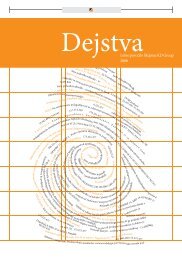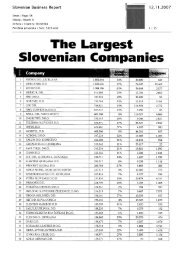The Group KD Group and KD Group dd
The Group KD Group and KD Group dd
The Group KD Group and KD Group dd
Create successful ePaper yourself
Turn your PDF publications into a flip-book with our unique Google optimized e-Paper software.
<strong>The</strong> <strong>Group</strong> <strong>KD</strong> <strong>Group</strong> Annual Report 2009<br />
Notes to Consolidated Financial Statements as at <strong>and</strong> for the year ended 31 December 2009<br />
2.8 Financial assets<br />
<strong>The</strong> <strong>Group</strong> classifies its financial assets in the following categories: financial assets at fair value through profit or loss; loans<br />
<strong>and</strong> receivables; held-to-maturity investments; <strong>and</strong> available-for-sale financial assets. Management determines the<br />
classification of its investments at initial recognition.<br />
2.8.1 Financial assets at fair value through profit or loss<br />
This category has two sub-categories: financial assets held for trading, <strong>and</strong> those designated at fair value through profit or<br />
loss at inception.<br />
A financial asset is classified as held for trading if it is acquired or incurred principally for the purpose of selling or<br />
repurchasing in the near term or if it is part of a portfolio of identified financial instruments that are managed together <strong>and</strong> for<br />
which there is evidence of a recent actual pattern of short-term profit-taking.<br />
Financial assets <strong>and</strong> financial liabilities are designated at fair value through profit or loss when:<br />
- doing so significantly reduces measurement inconsistencies that would arise if the related derivatives were treated<br />
as held for trading <strong>and</strong> the underlying financial instruments were carried at amortised cost for loans <strong>and</strong> advances to<br />
customers or banks <strong>and</strong> debt securities in issue; <strong>and</strong><br />
- certain investments, such as equity investments, are managed <strong>and</strong> evaluated on a fair value basis in accordance<br />
with a documented risk management or investment strategy <strong>and</strong> reported to key management personnel on that<br />
basis, <strong>and</strong> are designated at fair value through profit or loss.<br />
2.8.2 Held-to-maturity financial assets<br />
Held-to-maturity investments are non-derivative financial assets with fixed or determinable payments <strong>and</strong> fixed maturities that<br />
the <strong>Group</strong>’s management has the positive intention <strong>and</strong> ability to hold to maturity. If the <strong>Group</strong> were to sell other than an<br />
insignificant amount of held-to-maturity assets, the entire category would be reclassified as available for sale.<br />
2.8.3 Loans <strong>and</strong> receivables<br />
Loans <strong>and</strong> receivables are non-derivative financial assets with fixed or determinable payments that are not quoted on an<br />
active market, other than: (a) those that the entity intends to sell immediately or in the short term, which are classified as held<br />
for trading, <strong>and</strong> those that the entity upon initial recognition designates as at fair value through profit or loss; (b) those that the<br />
entity upon initial recognition designates as available for sale; or (c) those for which the holder may not recover substantially<br />
all of its initial investment, other than for reason of credit deterioration. If the loan is irrecoverable, it is written-off <strong>and</strong><br />
recognised in revaluation expenses - impairment of loans. Loans are considered to be irrecoverable when all the necessary<br />
procedures of recovery have been performed <strong>and</strong> the amount of loss can be determined. <strong>The</strong> subsequent repayments of<br />
debts written off reduce the impairment loss recognised in the income statement, providing the repayments are received in the<br />
current year; if not, they increase the revenue.<br />
2.8.4 Available-for-sale financial assets<br />
Available-for-sale investments are those intended to be held for an indefinite period of time, <strong>and</strong> which may be sold in<br />
response to needs for liquidity or changes in interest rates, exchange rates or equity prices.<br />
2.8.4.1. Recognition of financial assets<br />
Regular purchases <strong>and</strong> sales of financial assets at fair value through profit or loss, held to maturity <strong>and</strong> available for sale are<br />
recognised at the trade-date – the date on which the <strong>Group</strong> commits to purchase or sell the asset.<br />
Financial assets are initially recognised at fair value plus transaction costs for all financial assets not carried at fair value<br />
through profit or loss. Financial assets carried at fair value through profit or loss are initially recognised at fair value, <strong>and</strong><br />
transaction costs are expensed in the income statement. Financial assets are derecognised when the rights to receive cash<br />
flows from the financial assets have expired or where the <strong>Group</strong> has transferred substantially all risks <strong>and</strong> rewards of<br />
ownership. Financial liabilities are derecognised when they are extinguished − that is, when the obligation is discharged,<br />
cancelled or expires.<br />
93







